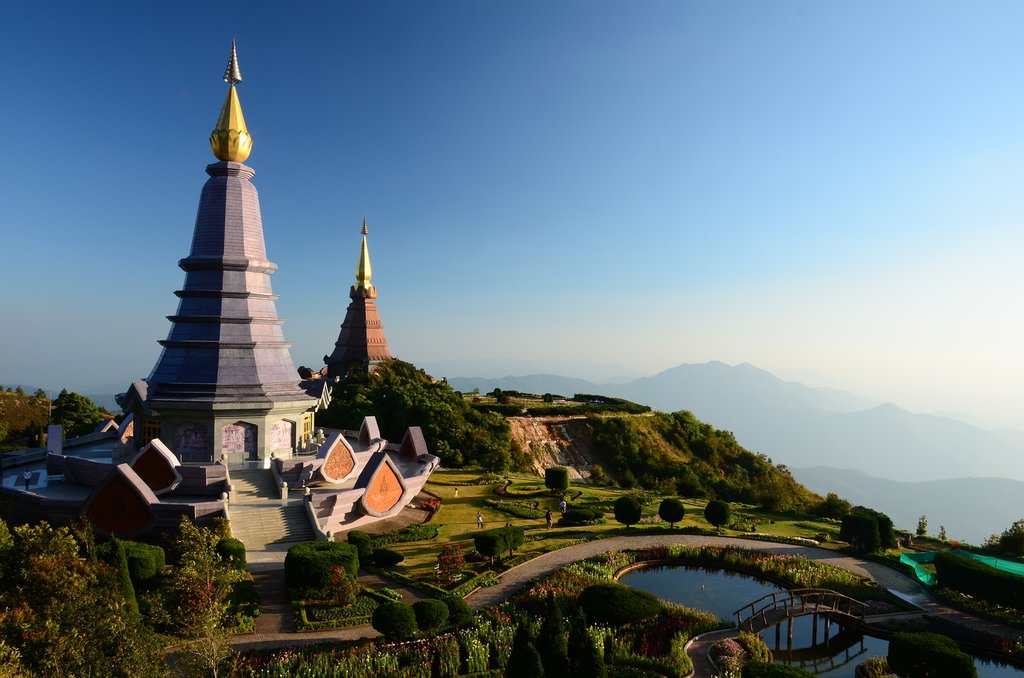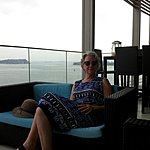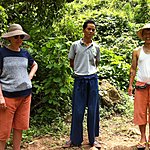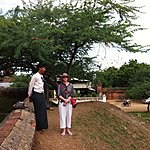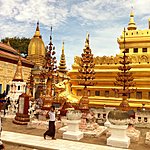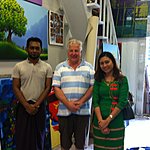Highlights
- Marvel at the golden spires of Bangkok's Royal Palace in Bangkok
- Enjoy the slower pace and spirituality of Chiang Mai
- Ride a boat through the floating gardens of Inle Lake
- Rise early for breathtaking views of Bagan’s temples at sunrise
- An exclusive visit to Shwedagon Pagoda, the symbol of Myanmar
Overview
Although side-by-side, neighboring Thailand and Myanmar are very different countries yet they both offer experiences and sights that are quintessentially Southeast Asian. There are no two better countries to tour to get a real understanding of this region. From ultra-modern Bangkok to the serene shores of Inle Lake, ancient Bagan to bustling Mandalay, Thailand, and Myanmar are exciting, colorful and rewarding countries to travel through. In two weeks you can visit many of the unforgettable highlights.
Chat with a local specialist who can help organize your trip.
Route map

Detailed itinerary
Day 1: Arrive in Bangkok

Thailand's capital is the quintessential eastern metropolis and arguably Southeast Asia’s most vibrant city. Ancient Thai temples decorated with gold and mosaic tiles rise magnificently from the riverbanks, colorful palaces glisten spectacularly in the sunlight, and the mighty Chao Phraya river snakes through the center of it all, with offshoot canals. Fabulous shopping also awaits, with
Fabulous shopping also awaits, with high-quality handicrafts and world-famous Thai silks, or excellent bargains in entertaining markets and stylish shopping centers. The fresh, zesty Thai cuisine is also something to look forward to.
Depending on your arrival time, there may be time for some city sightseeing. Head first to the royal enclosure, which houses the Royal Palace, a fantastic example of the uniqueness of Thai architecture, and Wat Phra Kaew, home to the Jade Buddha and Thailand’s most sacred religious site. Next, head to Wat Pho, one of the largest temples in the city and home to the enormous Reclining Buddha.
Day 2: Tour Bangkok
Start the day at the Damnoen Saduak floating market, about 100 km/ 62 miles southwest of Bangkok, where goods are bought and sold almost entirely on water. Take to the canals on a small boat, and enjoy watching the locals trade before trying a bit of bargaining for souvenirs or fresh fruit yourself.
In the afternoon, visit the Chinese quarter of Bangkok, one of the city’s most atmospheric and traditional neighborhoods. This area is a haven for foodies and photographers. An important trading center for centuries, Chinatown is a bustling urban maze where you can find almost anything… for a price!
Day 3: Bangkok sightseeing/ Travel Bangkok to Chiang Mai

This morning, take a colorful long-tailed speedboat down the wide Chao Phraya River, which meanders through Bangkok, heading for the canals (khlongs) of Thonburi. This is one of the most traditional areas of Bangkok, and the place where Bangkok was originally founded in the 16th century, before King Rama I moved the political epicenter to the other side of the river.
In Thonburi, you’ll find a water world of wooden houses on stilts, floating kitchens, colorful temples, and the odd crumbling European mansion. The river cruise will end with a visit to the imposing Wat Arun (or Temple of the Dawn), Bangkok’s most striking riverside temple.
In the afternoon, fly north to Chiang Mai, an ancient walled city of leafy green trees, winding alleyways, and spectacular cuisine. Northern Thailand’s most important cultural hub offers a huge variety of antique temples. The gentle city is also the gateway to the northern mountains, where you can visit the jungles, minority villages, and arrange treks.
Day 4: Tour Chiang Mai
Tour the leafy city of Chiang Mai via tuk-tuk, the most fun and appropriate way of getting around, considering the sights are quite spread out and the streets are narrow. Start at the 14th century Wat Lok Moli, then head to bustling Warorot Market, one of the most vibrant in the city, selling everything from food to clothes.
Head back to Chiang Mai city to shop for handicrafts. As the city was the old capital of the Lanna Kingdom (13th-19th century), you'll find lots of traditional Lanna crafts, such as silver work and fabric lamps. You can also find the crafts of other ethnic groups here, as Chiang Mai is situated in an ethnically diverse part of the country, close to both the Myanmar and Laos borders.
Next, ride to the old Doi Suthep, a temple on a mountain with the same name, 15 km/ 9 miles from Chiang Mai. Watch the chanting monks and then enjoy the sunset over the landscape.
Day 5: Visit an Elephant Camp in Chiang Mai, then travel to Chiang Rai

Elephants are the national symbol of Thailand, so most visitors will enjoy getting up close to the magnificent creatures. The ethics of riding elephants, and the way they are trained, have come under scrutiny in recent years, so it is not advised to ride the animals themselves. However, there are other ways of learning about and caring for these animals, and contributing to their wellbeing.
After lunch, proceed to Chiang Rai, Thailand’s northernmost big city. Chiang Rai offers visitors the chance to see the point at which Thailand, Laos and Myanmar meet, known as ‘the Golden Triangle’.
Visit the famous White Temple, or Wat Ron Khun, built in 1996. The jagged spikes of the temple emerge from a grassy garden like white fire, and the whole structure is elegantly reflected in the adjacent pond. This ambitious project was undertaken by local artist Chalermchai Kositpipat, and it reflects both movements in contemporary art and traditional Thai architecture.
Day 6: Chiang Rai to Inle Lake

This morning, head to Mae Sai, which sits beside the Ruak River, a stone's throw from neighboring Myanmar. On the way, visit the Doi Tung Royal Villa and the beautifully manicured Mae Fah Luang Garden in the northern highlands. This former residence of the King’s mother makes for a tranquil and scenic stop before exploring some ethnic Yao and Akha villages. The culture here is distinct for its striking architecture and the colorful clothing of the locals.
Cross the border at Mae Sai drive to the airport of Tachileik for your flight to Heho.
From Heho, it's a scenic one-hour drive to Nyaung Shwe, a gateway to Inle Lake. In the late afternoon, hop on board a long tail boat to reach your hotel on the lake.
Day 7: Inle Lake
After breakfast, hop back on your long tail boat and head onto Inle Lake, one of Myanmar’s most spectacular sights. The serene waters are full of vegetation and fishing canoes, with scenic hills in the background.
Visit the lake’s morning market (open every day except on full and new moon days). The market rotates between the lake’s villages on a 5-day schedule, and is visited by the lake’s inhabitants as well as the ethnics villagers living up in the hills. On your way, watch the fishermen use their traditional leg-rowing style, and see their ‘floating gardens’, made from water hyacinth and earth and anchored with bamboo poles.
Next, visit Nga Hpe Chaung Monastery, full of dozens of early Shan Buddha Images. Then continue to the Phaung Daw Oo Pagoda. You will also have the opportunity to witness many traditional crafts on the lake: lotus silk weaving, boat making, cigar manufacturing, blacksmithing, and silver smithing.
Day 8: Inle Lake to Indein

A 1-hour boat ride down a small canal will take you to the Pa-Oh village of Indein, on the western shores of Inle Lake. Take a walk around the village before ascending to the top of a hill. The Indein Pagoda complex consists of hundreds of small stupas that are overrun by moss and greenery, and is undoubtedly an impressive site. At the summit you will be greeted by a Buddha sitting enshrined among hundreds of stupa ruins and overgrown shrubbery. From the peak you will be rewarded with views of the placid surroundings.
On your boat ride back, if there's time, stop at the Inthar Heritage House to learn more about the history and culture of the lake's indigenous people.
Day 9: Travel Inle Lake to Pindaya

After breakfast, head back to Nyaung Shwe and drive to Pindaya (90 km/ 56 miles; 3 hours) a quiet town on the banks of the serene Botoloke Lake. Stop at a local workshop that makes handmade paper and traditional wooden umbrellas. The process has not changed for generations, and the beautiful crafts make perfect gifts.
Visit the renowned Pindaya caves, estimated to have been formed more than 200 million years ago, which house thousands of Buddha images. To reach the opening of the cave, walk past the giant white Shwe U Min Pagodas.
After visiting the caves, take a short walk to a nearby village, where a local family will teach you about tea cultivation, tea leaf salad, and other regional delicacies. Pindaya tea leaves are known throughout Myanmar as the best in the country.
Day 10: Travel Pindaya to Mandalay

The drive from Pindaya to Mandalya (280 kms/ 174 miles; 8 hours) passes through the Shan Hills on a winding road. From the car you can glimpse rural Myanmar.
Arrive in Mandalay, the second largest city in Myanmar, and one of the ancient royal capitals. It's a booming modern city beside the Irrawaddy River. Despite its energy, it's where Myanmar's cultural heart lies, and traditional music, dance, and drama can be found.
Day 11: Tour Mandalay and around

Visit the Mahamuni Pagoda, which houses one of Myanmar’s most honored Buddha images, then head to one of the many handicraft workshops to meet craftspeople working with gold leaf, tapestries, wood carvings, and marionettes. Next, visit Kuthodaw Pagoda, dubbed “the world’s biggest book” for its collection of 729 marble slabs inscribed with Buddhist teachings. Then, off to the Shwenandaw Monastery, the Golden Monastery celebrated for its remarkable woodcarvings.
Cross the Irrawaddy River to Sagaing, 20 kms/ 12 miles from Mandalay, with its 600 ivory colored pagodas and monasteries. Sagaing Hill is considered the spiritual hub of Myanmar, and is home to around 3000 monks. Explore its temples, its bustling market and the small pottery village.
Continue on to the old capital of Amarapura (18th-19th centuries), with its gorgeous monasteries. Finally, head to the legendary U Bein Bridge, built in 1782. Enjoy the special atmosphere in the late afternoon, as the sinking sun illuminates the teak bridge. Head back to Mandalay for the night.
Day 12: Mandalay to Bagan

Travel from Mandalay to Bagan (4.5 hours) along a beautiful road that follows the east bank of the Irrawaddy and passes charming villages along the road to Myingyan. Fields of millet, sesame, cottonseed, corn, rice, and many other legumes dot the landscape. Stop for a break in Myingyan, and then at the tiny farming village of Shwe Pyi Tha.
Bagan is known as one of the greatest architectural sites in Asia. From the 11th to 13th centuries it was the center of Myanmar, and the monarchs built 10,000 massive stupas and pagodas, over 2000 of which are still present on the shores of the Irrawaddy River. Visiting Bagan is likely to be the highlight of many trips to Myanmar.
Day 13: Around Bagan
Early in the morning you can opt to take a hot air balloon ride over Bagan's countryside, observing one-of-a-kind views when the sun rises over the Irrawaddy River and the numerous stupas. (Note: hot air balloon rides are only available from October/November through March).
Next, visit the vibrant Nyaung Oo Market, trading fresh produce and other goods. From here, visit the renowned golden Shwezigon Pagoda, then explore nearby villages to get a glimpse of the local lifestyle on Bagan’s plains. Continue to more lesser-known monuments.
See the manufacture of one of Myanmar's most popular handicrafts at a traditional lacquer workshop, then continue to Ananda Temple, one of Bagan’s most gorgeous temples and home to two distinctive Buddha images. Their expressions appear to transform, depending on the angle from which they're viewed. From here, take a horse cart journey past some of the tallest temples in Bagan.
To finish off the day, enjoy the sunset from an elevated position amid the temples, from which you can see the light illuminating the red brick and gold of the temples.
Day 14: Bagan to Yangon

This morning, fly to Yangon.
Start your tour of Myanmar's largest city by visiting the Kyaukhtatgyi Pagoda and its 70-meter long reclining Buddha statue. Afterwards, continue uptown and make a quick stop by the Royal Lake in Kandawgyi Park, a very popular spot with local residents. Spot Karaweik Hall, a reproduction of a royal barge.
No Myanmar expedition can be considered complete without a visit to the legendary Shwedagon Pagoda, a magnificent gilded pagoda that is an icon of Myanmar. The outside is adorned with over 40 tons of gold leaf, and numerous diamonds. Arrive in the late afternoon and start your tour of the pagoda at the eastern staircase, where a row of shops at the base sells various religious items. Shwedagon is considered to be the most important religious site to the Burmese people, as it's said to house strands of Buddha's hair.
Day 15: Depart Yangon
If there's time before your departure, explore Yangon's colorful downtown area, full of multicultural neighborhoods and colonial architecture. Starting at Mahanbandola Road, walk through alleyways crammed with food stalls and markets, and discover the many colonial buildings that were once the pride of Yangon, which used to be called Rangoon.
Head back to Sule Pagoda, and continue through the chaotic Indian and Chinese quarters. Explore the gold shops and take a look at the Moseh Yeshua Synagogue on 26th Street, before reaching Theingyi Zei Market and exiting onto Anawratha Road, looking out for the Sri Kali temple, Yangon’s most colorful Hindu temple. If you still have time before your flight, fit in some last-minute souvenir shopping at Bogyoke Market, filled with handicrafts.
